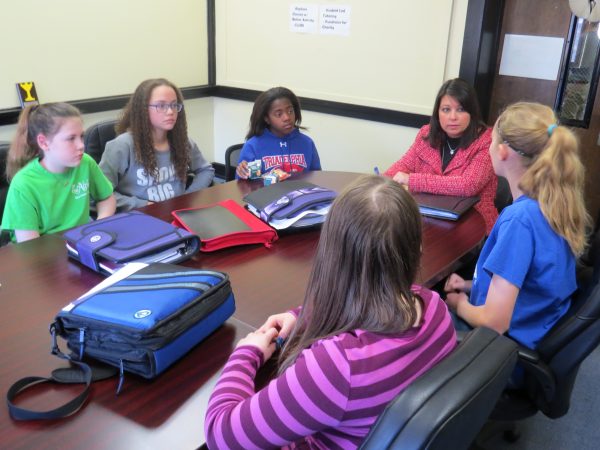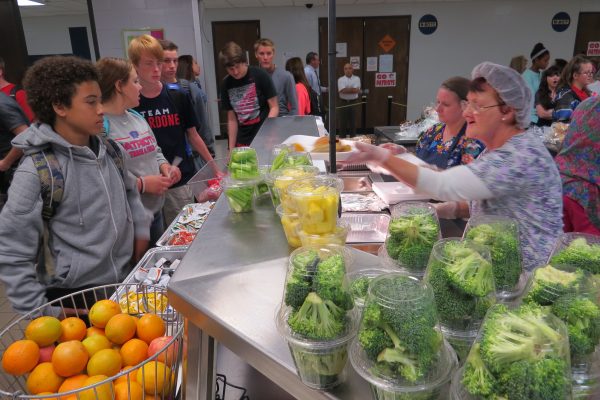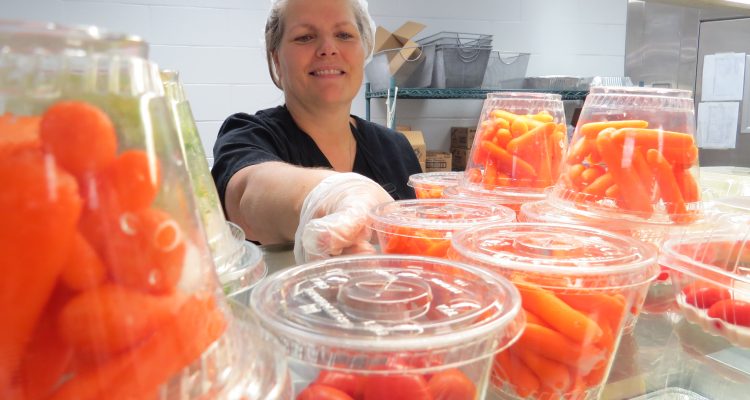(Editor’s Note: This is the fourth in a series of articles featuring Ohio County Schools, the district’s new superintendent, and the new direction of the district.)
Remember that cheese sandwich?
Two slices of white bread slathered with mayonnaise with a few slices of American cheese in the middle? Maybe, even, a slice of tomato if the garden was ripe.
Yeah … no more.
Now, parents in the Wheeling area these days are free to send their children to school with something similar, but it’s most likely they will opt for the free breakfast and lunch programs that are now available in all Ohio County Schools. The programs, funded by federal and state governments, allow for the preparation and service of nearly 5,000 meals per day.
“We are very excited about these programs because we know that children who have a good breakfast and lunch will produce in the classroom,” said Superintendent Dr. Kim Miller. “They are more alert, they are more on task, and they are more engaging. Plus, we’re not sure what’s taken place before they arrived at school. Maybe Mom was running late and didn’t have time to make breakfast. Who knows?
“But now our parents do not have to worry about those situations because they know that when they get to school, there will be a healthy meal ready for their children,” she continued. “I know, as a mother of two daughters who are students in our school system, now they will definitely have those meals, and that takes some pressure off parents.”
The programs will take pressure off the children, too, according to Renee Griffin, the director of child nutrition and wellness for Ohio County Schools the past six years.
“And that’s because these programs also take that stigma away because no one has to apply for free or reduced benefits. Now everyone is the same, and that means everyone gets to eat the same way,” she said. “People were embarrassed to apply, and the students had to bring the applications into the office. I’m not sure how many people understand how much stress that put on those individuals. There’s just no need for that now that the problem is gone.”
So, when classes begin tomorrow, what can the students expect to see on the breakfast and lunch menus that will fit under the federal and state dietary mandates?

Pancakes and maple syrup? “Occasionally,” said Griffin, a registered dietician for more than 20 years.
Cap n’ Crunch? “Nope.”
Fruit Loops? “We purchase it with reduced sugar.”
Sugar Smacks? “Um, no.”
Frosted Flakes? “The kind with reduced sugar, yes.”
“We know that sugar is a big deal when it comes to nutrition, and that’s why we offer what we do and what we do not make available to the children,” Griffin explained. “Today’s kids like the grab-and-go options like the breakfast bars, and we also have breakfast sandwiches, French toast sticks, and a lot of different fruits are available, too, in the mornings.”
The typical lunch service will include, say, a serving of a slice of pizza, a spinach and tomato salad, a yogurt cup, and some slices of mandarin orange, or a grilled chicken sandwich with lettuce, corn, a fresh plum, and a choice of another side dish from a plethora of possibilities.
“If the kids or the parents want to see what’s going to be served, they can always go to our website and see the menus because they are all posted online,” Griffin explained. “And we will always have salad entrees available, a wide variety of fruits and vegetables and leafy greens, and we now serve things like fish tacos, brown rice, beans, hummus, and several different wraps.”
What about hamburgers? “Absolutely,” Griffin said. “We even have garden burgers for those who prefer the vegetarian option.”
Spaghetti? “Yup.”
Meatloaf? “Occasionally, but the kids don’t love it.”
Tater tots? “Occasionally, and sometimes even sweet potato tots.”
Chili dogs? “Not too often, but honestly that’s also because it’s not popular with the student body.”
Chili dogs, not popular with the students? It’s true and that’s because a change has taken place from one generation to the next as a part of an educational process that includes lessons in nutrition during breakfast, lunch, and health classes, and also during their science and even math lessons these days.
“A hungry student has a lot of problems learning anything because they are thinking more about getting something to eat than what’s being taught in the classroom,” the superintendent said. “We’ve learned that as our society has changed, hungry students have been a problem every administrator and every teacher has had to deal with.
“We’ve also learned that it’s not just about feeding the hunger, but also about feeding the hunger the right way, and that’s the healthy way.”

Eat Better, Feel Better
More than 40 service personnel employed by Ohio County Schools work in the child nutrition department, and beginning tomorrow at 6 a.m. they will begin the process of preparing as many as 3,000 breakfasts and more than 5,000 lunches. The first meal of the day is prepared at each school, but the central kitchen based at Wheeling Park High School handles all of the lunch servings, which are transported to the schools by three food trucks.
“It’s a well-oiled machine, and it operates very well,” Miller said. “But the food has changed over the years, and that’s because more people are paying attention to what they are eating these days. We’ve just learned so much about what we consume, so the children in school today are eating much better than what I did when I was going to school.
“Not only are they eating better in our schools, but they are also learning why they are eating better, and the hope is that they will continue that for the rest of their lives. I know I have learned a lot over the years about how to eat healthier, and it’s made a difference.”
So back to that cheese sandwich; remember any fruits and vegetables as side dishes, or just a pack of HoHo’s and maybe an apple or an orange? What about broccoli, black beans, or brown rice?
“I believe that absolutely the food we serve to our students is much better for the body than what I was fed while I was in school,” said Griffin. “We serve a lot more fruits and vegetables than what they did then, and the kids today are healthy consumers, and they are eating more and more fruits and vegetables now outside of school than ever before.
“And we do have a lot of guidelines that are in place now concerning the nutritional values of the foods that we are serving,” she continued. “For example, we no longer have sugary drinks at the schools during the school days, but water is available all of the time. And we have calorie levels that are set for the elementary, middle and high school levels to be sure we are meeting those nutritional needs.

“In West Virginia we have more stringent standards than what has been set forth by the federal government. Policy 4321.1 is a state policy that dictates what foods can be brought into our schools,” Griffin explained. “For example, no cupcakes from Mom or Grandma are permitted. A child can bring them for themselves, but they are not allowed to share them because of food safety concerns. We now know that we are feeding children with under-developed immune systems, and that means you can run into some problems.”
Just as some parents have expressed issues with Common Core Standards because the new educational process involved with instructing curriculum is totally unfamiliar to them, the same, at times, is expressed about what is served by the lunch ladies these days.
“A lot of the meals that were really popular 30 years ago are not any longer. Kids today do not want those types of foods,” Griffin said. “A turkey dinner used to be our biggest meal of the year, but that’s not true today. They like anything chicken, like tenders and nuggets, they like pizza, and the tacos seem to be their favorite dishes these days.
“Ultimately, what I try to do is pair their favorites while still meeting the requirements because, let’s face it, if we are feeding garbage cans, the children are not getting good nutrition,” she said. “We want to make sure that they are eating the food that we are providing because it’s making them better students.”
The chicken nuggets and the taco salads are the most popular dishes, and chicken quesadillas, pizza, and nearly anything served with the brown rice proved the most popular last year, but Griffin is well aware the child nutrition department is incapable of pleasing every child and all of the mothers and fathers.
“It’s food service, and that’s why, ultimately, I try my best to allow the children to have a voice,” she said. “I like to meet with student councils, and I also go to the schools and meet with different groups of kids so I can hear from them what they want and what they like and don’t like.
“I also explain to them why they are seeing what they are seeing during those meals,” Griffin continued. “For example, we have to have a half cup of beans every single week, and that means they might get tired of baked beans, so we change it up while also meeting the requirements. So I try to explain to them how we are going about it, but I also like to listen to them, too, so they have a voice about what they might like to see served.”

Impact and Ripple Effects
There was a time, about 30 years ago, when those smokers along the sidelines considered a football player a sissy when he would ask a coach if he could get a drink of water during an August two-a-day practice.
But now, because of the removal of ignorance concerning the workings and nutritional needs of the human body, hydration is for everyone and so are fiber, minerals, and vitamins.
“We are a very knowing society these days, and kids know the dietary factors, they know to read labels, and they know how much fat is in something,” Miller said. “The kids are aware, our teachers are aware, and our parents are aware of health and fitness. That’s who we are now.”
One of the reasons for the awareness among the students is that a wellness coach has been placed at each of Ohio County’s 13 public schools for the past few years and will be once again beginning tomorrow. Griffin, as the nutrition director, consistently sits down with those employees throughout the academic year to collaborate and offer updated information.
“The wellness coaches are the champions in our schools as far as nutrition and wellness, and they work with the wellness councils so they can come up with ways to promote wellness,” she said. “Some of the schools have had walks, and they have had special programs to add to the information that’s already been included in the classroom.

“Every school is a little bit different with how they promote wellness, but we are very lucky to have those wellness coaches,” Griffin continued. “They are able to continue delivering that message about how important a good diet is to good health now and down the road.”
So forget that cheese sandwich and HoHo’s, and most of what can be recalled from even 10 years ago. It’s smart, it’s healthy, and getting healthier by the day, and it is kind to the parents’ bottom line. The statistics on overall health in the United States have revealed in recent years the people of West Virginia represent one of the worst state populations when it comes to well-being and quality of life.
Too many smoke too much, they eat fast food in excess, and they gulp down a lot of Mountain Dew, too. But not in the public schools in Ohio County.
“There are a lot of nutrition guidelines, but there is a reason for that. It’s sound science,” Griffin said. “This isn’t just the USDA just throwing these things out there. There is a lot of scientific research behind why kids need to eat healthier. And we have a generation where obesity is such a big problem, and what they are eating can directly impact that issue.
“That’s why we need to make sure they are getting enough fiber, not eating so much sodium, and filling up on fresh fruits and vegetables,” she continued. “That kind of diet allows them to learn more in the classroom, and it prevents a lot of problems down the road.”
(Photos provided by Ohio County Schools)



